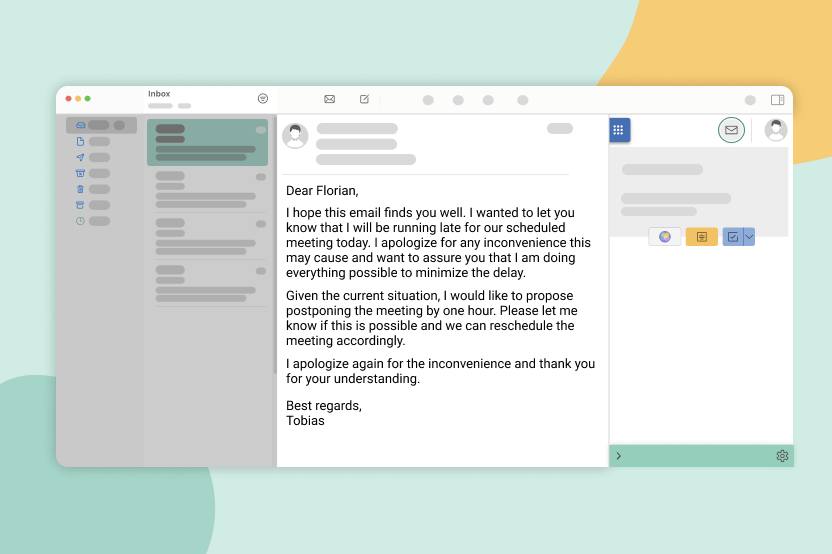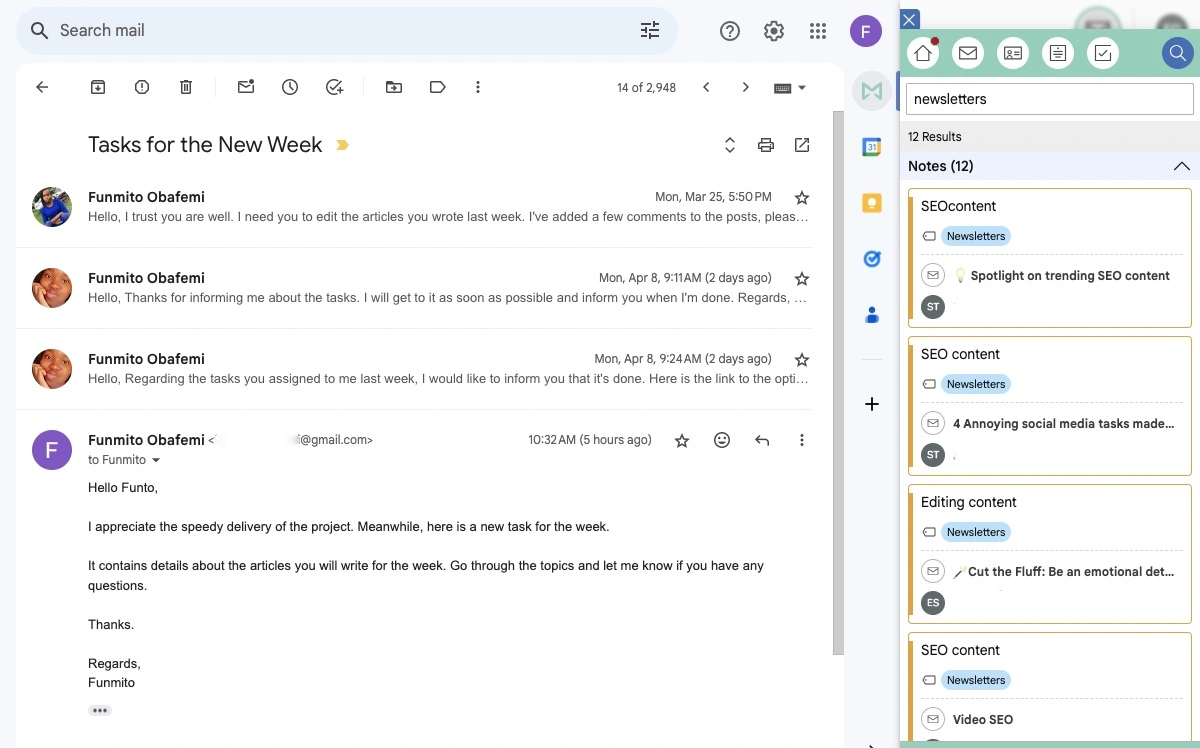Shared inbox software: Boosting team collaboration and productivity
Manage team emails efficiently with shared inbox software. Assign emails easily, and boost productivity across your entire team.
Learn the best practices for an email thread to boost collaboration and keep your email chain clear and organized.
Irena is an experienced Content and Email Marketer who loves animals, slow mornings, and all things Tolkien.
Imagine going back and forth on a topic in an email conversation. And those pieces of email content appear individually in your inbox.
Wouldn’t you find that as a clutter that makes your inbox overload? This is where an email thread becomes useful.
An email thread groups a series of messages that relate to a particular topic in a single place. It organizes your inbox and makes it easy to find a specific message.
In this article, you will learn more about an email thread, its advantages, disadvantages, and some best practices to use them effectively.
The email thread definition, also known as an email chain, is a collection of an original email message and its replies in a single group.
An email thread occurs when you and another party discuss the same topic in different emails. The thread strings all these email conversations in a line, enabling you to track all discussions and provide contexts for new participants.
Email threads are mostly used in business settings, especially between project teams, customer support, sales, and general correspondence. Here is what an email thread looks like:
![]()
The screenshot above has the figure, (3) beside the name of the participants. This indicates four emails in this conversation, including both the sent and received messages.
However, an unthreaded email looks like this:

As you can see, each email shows up individually in the inbox. It doesn’t show they talk about the same topic either.
Today, many email extensions play a huge role in managing email threads efficiently. They can help you find specific email messages, track their details, and simplify all communication processes.
Email threads are beneficial in a variety of ways. Some of these include:
When people exchange multiple emails about a particular topic, it’s easy to lose track of some conversations and miss vital information. But with an email thread, you will see all conversations in a single place.
Mailbutler’s email tracking feature makes it easy to see whether a particular email in a thread was opened or if the links in the email were clicked.
It also allows you to know whether your email got to the recipient’s inbox. This enables you to determine the right time to follow up on the conversation.
The example below displays how the tracking feature works. It shows whether the recipient opened the email, clicked the link, and shows some other useful details.

Mailbutler's email tracking dashboard
Email threads provide you with previous interactions relating to a particular email. With this information, you can refer to past emails in a thread, understand the ongoing issue, and offer a suitable response.
To quicken the process, you can use Mailbutler’s Smart Summarize feature to highlight the key details in the thread and extract useful information. This saves you time, especially when you have a lengthy email.

Mailbutler's Smart Summarize
Without an email thread, the volume of emails in your inbox will increase. This makes it challenging to navigate and manage your inbox effectively. Plus, it becomes time-consuming when you have to click on each email and search for relevant information.
However, an email thread makes it easy for you to group similar conversations, simplifying the communication process. Rather than having a long list of different email messages, you can have them all filed up as one email.
Besides, you can use features like Mailbutler’s Tags to easily navigate these messages instead of searching for them individually. All you need to do is attach the tag to the email and search for it in the Mailbutler’s menu bar when you need it.
Here is an example of how the email tag feature worked in this email thread. After tagging several emails as “newsletters,” it was easy to discover different emails bearing that tag and refer to them.

Mailbutler's email tags example
Although there are various benefits to using an email thread, here are some of its disadvantages:
An email thread allows you to include multiple recipients. This is a great idea as it creates an efficient way of communicating with people. However, you can receive unwanted messages in your inbox, especially when the thread is too long.
Plus, you could confuse or annoy your recipients if the messages weren’t intended for them. The only way to avoid this scenario is to include the necessary participants. This keeps you organized and delivers accurate information to the right audience.
In the case of a serious discussion that involves going back and forth with several email messages, the email thread eventually becomes very long. This makes it difficult for a participant who hasn’t been keeping up to find the right messages that provide accurate context. Plus, they might end up wasting time in a bid to find the specific message that they need.
Despite its advantages, email threads can end up as a mess in the event of clutter or lengthy messages. Here are some best practices to simplify communication while using email threads.
Many emails become too long because the participants deviate from the original subject. This contributes to inbox cluttering, making it hard to find useful information.
One major way to avoid this situation is to inform your recipients to discuss the topic. Ensure that they focus on the key points. Use plain and simple English to communicate in a way your participants will understand.
Also, if they need to discuss other topics, they should start a new thread or use a different channel to communicate the topic. It prevents the thread from getting too long and ultimately confusing the participants.
Your subject line captures the essence of your email thread. It’s the first thing your recipient will see about your email. Hence, you can’t afford to use vague details that confuse your recipients or make it hard to find your email.
Instead, keep it short, concise, and descriptive. It will not only provide a better understanding of what your email is all about. It can also help your recipient when they search for specific discussions later on.
Emails are a major communication channel for businesses. As a professional, you should communicate formally so that your message is taken seriously.
Be careful about your word choices. Avoid casual language, sarcasm, slang, or excess emoticons that can make your message unprofessional to your audience.
Structured emails make it easy for your readers to skim through and understand the content. A proper email thread should feature a clear subject line, modest salutation, body, closing line, and signature.
You should separate these five parts as paragraphs instead of compiling them as a single sentence. Include white space where necessary.
Plus, you can use bullet points and number lists to highlight key details. This makes it easy for your recipient to read, make decisions faster, and give responses.
In your email thread, avoid adding people if the messages aren’t relevant to them. You could clutter their inbox and end up annoying them.
Instead, you should use the BCC and CC features when adding multiple recipients. While the CC allows your recipient to see everyone involved in the message, the BCC can hide these details.
It serves as a data protection feature that allows only the sender to know the list of people who receive the email. This ensures the right participants are involved in your conversation.
You can forward an entire email thread in Gmail. To get started, click on the email thread and click on the three dots in the menu bar.
You will see “forward all” as the last command on the list, click on it, add the recipient’s email address, and click “send.”

If you know the names of the people you are addressing, you should start the email with “Hello + names” For example, you can have “Hello Jack, James, and John.”
If a common objective unifies your recipients, you can address them based on that purpose. For example, you can use “Dear Team” or “Dear Members of the Council.” If you aren’t familiar with your recipients, you can address them as “Dear All” or “Hello.”
When you want to forward an email without the thread, select the particular email in the thread. Click on the right side of the screen. You will see a long list displaying different commands. Click on “Forward,” include the recipient’s email address, and tap “Send.”

The term "email thread" is more commonly used and widely recognized when referring to a series of related emails. These emails are grouped together because they share a common subject line or topic, making it easier for users to follow the conversation as a whole. Each response in the conversation adds to the thread, much like beads strung on a thread.
In contrast, "email trail" can sometimes be used to describe the same concept, but it is less common and not as universally understood. The idea behind calling it a trail might come from the visual of following a path or tracking through the responses, but "email thread" remains the preferred and correct term, especially in formal and professional settings.
Another name for an "email thread" is "email chain." This term also describes a series of connected emails. Each email in the chain contains previous messages, which helps everyone in the conversation see the full context.
In conclusion, email threads are useful for grouping emails with related topics together. They organize conversations and simplify the communication process.
However, if you need an email extension that can provide a seamless experience with email threads, we recommend Mailbutler.
Mailbutler's email tracking software enables you to see whether the other participant opened your email or even clicked the link in the thread. Plus, you can use their email tags to neatly arrange your inbox and find a specific message in times of urgency.



